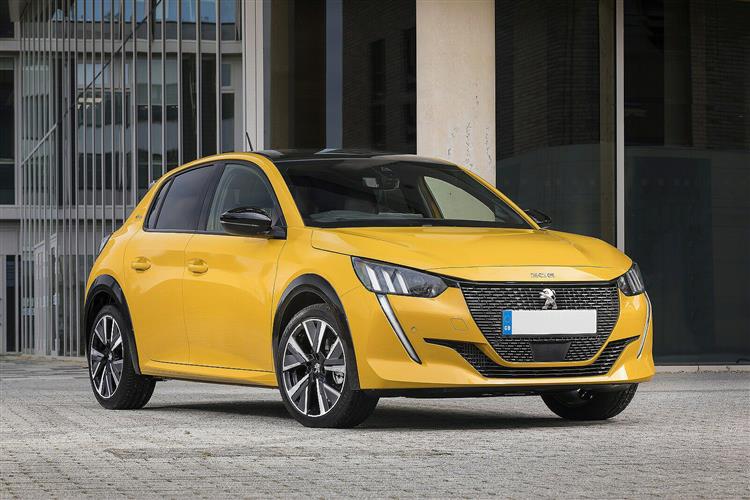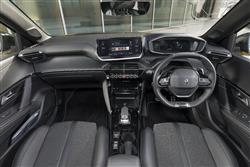AN EIGHT TO RATE (some text hidden) --NONE--
By Jonathan Crouch
Introductionword count: 93
In 2019, for the first time in nearly 40 years, Peugeot brought us a small car that really pushed the boundaries in supermini design. This second generation 208 model's engineering may not have been quite unique, but all the feel-good stuff really was - the pavement presence, the avant garde cabin. Plus that was delivered with most of the practicality and efficiency buyers needed from a small hatch. Here was a car that made other brands in its sector really sit up and take notice. Let's check it out as a used buy.
Modelsword count: 12
5dr supermini (1.2 petrol, 1.5 diesel, EV) [Active, Allure, GT Line, GT]
Historyword count: 342
If you're going to design a really ground breaking supermini - say one that could be produced on the same production line with either petrol, diesel or full-electric powertrains - shouldn't it make a fashion statement as well as an engineering one? Well this car does, the second generation Peugeot 208. We've rarely had to talk about 'generations' with Peugeot superminis before because they've always been badged differently, ever since the brand properly established itself in this segment with the much admired 205 back in 1983. Subsequent successive models (the 206 of 1998, the 207 of 2006 and the original 208 of 2012) were less appealing, but still sold well. But that odd evolving numerical naming convention wasn't great for building model line loyalty, which is why the brand put a stop to it - or perhaps they just didn't own the rights to '209' and '210' - who can tell? Anyway, it was ironic that this MK2 model 208, launched late in 2019, kept its name because it was easily the most fundamentally radical and different small Peugeot supermini since the 205. Perhaps we should qualify the term 'different'; the CMP ('Common Modular Platform') and all the basic engineering here was, after all, exactly the same as it was in the Stellantis Group's other small car products of this era, the Vauxhall Corsa and the DS 3 Crossback. But even in this company, this Lion-branded model manages to stand out. Peugeot clearly set out its stall here. A Ford Fiesta may sell on price and the way it drives; a Volkswagen Polo may sell on quality and the way it rides. But this Gallic brand was determined that a 208 should sell on style, technology and the way it makes you feel. In a segment that back in 2019 was otherwise full of contenders all trying to copy those two market leaders, that was rather refreshing. The MK2 208 sold in its original form until mid-2023, when it was significantly facelifted. It's the pre-facelift version though, that we look at here.
What You Getword count: 616
If you want this second generation 208, it'll be because you think it looks like nothing else on the road. And you'll be right. The front end is probably the most immediately arresting part of the design, with distinctive LED corner 'fangs' that flow up into the three-claw LED headlight signature. Look further up and you'll note the pared-back windscreen that allows space for the larger sculpted bonnet, the forward tip of which shows off the 208 badge. At the rear, the avant garde theme continues, with exact design and tautly-drawn shaping. In profile, things are a touch more conventional, though if you're familiar with the previous generation model, you'll immediately notice this squared-off 'C'-pillar (which is a nod to the old 205 model and has curious recessed indentations); and you might also note just how much larger and lower this MK2 design is, with its wide wings and curvier body. Inside, it certainly has a very futuristic feel - and one of very high perceived quality, thanks to the two-tier fascia layout, with its smart carbon-trimmed concave inner section that curls around the edge of the cabin and on into the doors. As with the previous 208, this cabin champions Peugeot's unique so-called 'i-Cockpit' format, where you view the instrument binnacle over the upper rim of a tiny steering wheel rather than conventionally through the wheel spokes. Here though, the concept was further developed with the addition of a 3D instrument binnacle display for plusher variants. This sees critical information like speed and navigational instructions projected in hologram form from the inner roof of the binnacle on to a piece of slanted Perspex in the foreground. Other secondary stuff features on a screen set further back and a button on the left of the steering wheel allows you to differently format the whole set-up according to preference. More media technology sits to your left in the form of the usual centre-dash touchscreen, normally 7.0-inches in size for 208 buyers but available on plusher models in larger 10-inch form. Either way, the monitor includes plenty of functions - too many in fact because you have to use this display to operate all the climate functions, which means switching out of whatever you're looking at every time you want to change temperature or fan speed. At least the seven stylised piano-style keys below this monitor look rather nice, positioned in front of a row of touch-sensitive short-cut buttons just behind. The seats are reasonably comfortable, there's not much wrong with the ergonomics, there's a reasonable amount of cabin storage space and there are plenty of media connectivity points plus, on most models, you get a wireless charging mat too with its own neat lidded compartment. At the rear, once inside, it's actually not too bad; there's certainly less room than there was in the previous generation 208 (despite the fact that this MK2 model has a fractionally longer wheelbase length), but there's not much less space than you'd get in the back of a Fiesta for instance, though that's not really saying much. Overall, larger adults probably wouldn't want to be spending too long here. But does that matter, given that for the majority of buyers, these rear seats will be used only occasionally for those above school age? Only you can decide. Finally, let's consider the boot, which is 311-litres in size - which is 26-litres more than was on offer in the previous generation model and 19-litres bigger than the trunk of a Fiesta but is a capacity figure that remains about average by class standards. It's quite a usable, squarically-sized space though, with 674mm of length and 1,018mm of width between the wheel arches.
To see the full road test text contact us on 0330 0020 227
Pictures (high res disabled)

.jpg)
|
.jpg)
|
.jpg)
| |||
.jpg)
|
.jpg)
|
.jpg)
| |||
.jpg)
|

|
Scoring (subset of scores)
Category: Small Runabouts
| Performance | |
| Handling | |
| Comfort | |
| Space | |
| Styling, Build, Value, Equipment, Depreciation, Handling, Insurance and Total scores are available with our full data feed. | |



